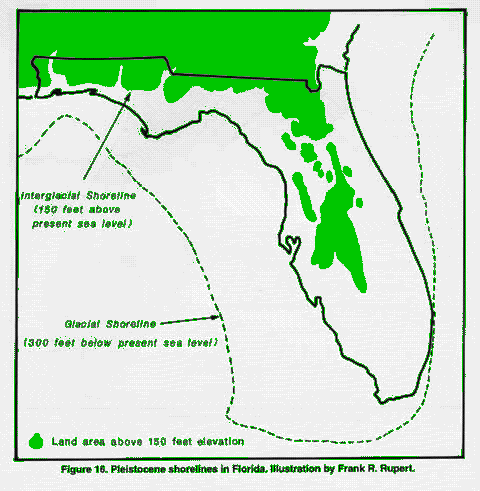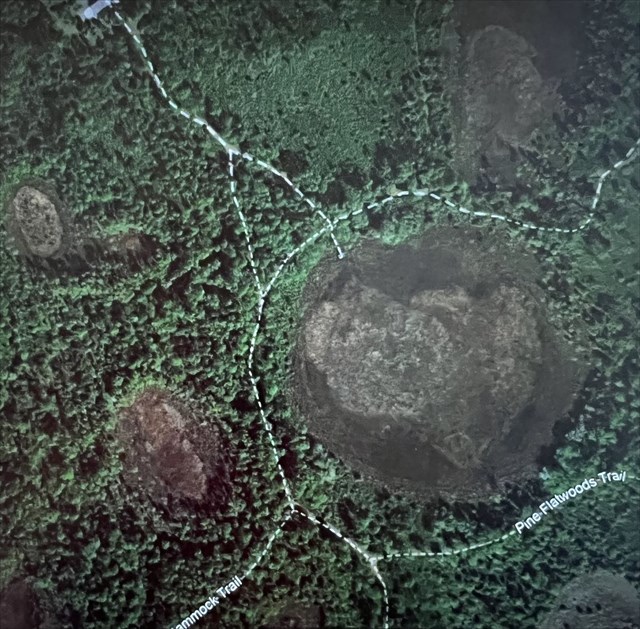To answer these questions, you will have to hike approximately 2 miles. During the rainy season, parts of the trail may be wet and muddy. Coordinates are for parking.
CREW (Corkscrew Regional Ecosystem Watershed) is a 60,000 acre watershed. A watershed is an area of land that absorbs rain and ground water and then drains it into a wetland. The CREW marsh is a 5000 acre wetland which holds onto the water it receives allowing the water to slowly sink into the ground. The marsh protects downstream areas from flooding during the rainy season and stores water for use during a drought. The plants in the marsh, dominated by sawgrass, filter the water, removing pesticides and other substances harmful to humans. After it is cleaned, the water through the force of gravity sinks into the ground through the spaces in the soil and bedrock ( rock that underlies the soil) recharging the underground aquifer. An aquifer is a permeable layer of bedrock that stores and conducts the water. The bedrock in the CREW marsh is composed of limestone which makes a good aquifer. This aquifer is the main source of drinking water for this part of Florida. Most of the 55 inches of annual rainfall the marsh receives comes in the summer and fall.
BEDROCK
The Ice Age had a tremendous effect on the formation of south Florida. The Ice Age spanned both the Pliocene and the Pleistocene Epochs of geologic history. This was a period of approximately 4.9 million years. 5 million years ago much of Florida was covered by a shallow sea. Coral and other marine creatures made up the bottom of the sea. Then, during the Ice Age, huge glaciers covered much of North America. As water became trapped in ice, the water levels dropped and this marine bed was exposed, drying out the corals and other marine animals. The ice melted (interglacial period) and south Florida was again covered with sea water. This process repeated itself numerous times during the Ice Age, each time depositing more marine animals on top of the old sea beds. The most recent glacial ice that covered the northern United States through the Midwest retreated 10,000 years ago. Thru time, these marine shells hardened into limestone. This limestone is the bedrock of the CREW marsh.

Florida’s shorelines showing the high water levels and low water levels during the Ice Age. (Diagram from the Florida Geological Survey)
VEGETATION and SOILS
The Pine Flatwoods is a plant community dominated by needle-leafed slash pine with palmettos beneath them. It is the highest and driest wildlife habitat found at CREW. The trees get their name from the early settlers who “slashed” the bark of the pines and collected its sap to make turpentine and rosins. The Pine Flatwoods are dotted with seasonal ponds or depression marshes that have water in them only during the summer/fall rainy season. Soils in the pine flatwoods are generally sandy and acidic due to the acid nature of pine needles. These are generally nutrient poor soils. Pine and palmetto bushes tolerate these poor conditions well.

Depression marsh (brown) surrounded by Pine Flatwoods (green)
The OAK HAMMOCK is closer to the marsh so the soil is different allowing moisture-loving plants to grow. The shade, the cooler air, and the sprawling oak tree limbs indicate a slightly lower elevation than the Pine Flatwoods. Even slight changes in elevation mean different soil and vegetation. The Oak Hammock is home to many birds including Warblers which gather here during the winter migration. Florida’s state butterfly, the Zebra Longwing, can also be seen in this habitat.
CREW is rich with Wildflowers. April is the peak of wildflower season but you can find something blooming any time of the year. The entire watershed also creates habitat for a wide variety of plants and animals including the Florida Panther, black bear, bobcat, deer, alligators, raccoons and numerous species of birds.
A trail map is available at the information boards near the trailhead. Begin at the trailhead and follow the trail to the observation tower. Then take the Popash Slough Trail, returning by way of the Hammock Trail. Please stay on the trails, no bushwhacking required.
To log this cache, please email the answers to the following questions:
1) At N26° 29.497 W081° 32.022, there is a large piece of the bedrock displayed.
A. What are the most common marine fossils in this limestone?
B. At this location, what type of tree dominates this landscape? Describe the soil here in terms of color and texture
2) At N26° 29.398 W081° 31.917, there is a depression pond surrounded by the Pine Flatwoods. Using the gauge in the pond, what is the water depth?
3) At N26° 29.004 W081° 31.976, climb the tower and take a picture of yourself with the marsh in the background. Post this picture online when you log your visit.
4) At N26° 28.931 W081° 32.290, the live oak is approximately 200 years old.
A. Estimate its circumference at chest height.. (Hint: your arm reach is approximately equal to your height.)
B. Describe this soil in terms of color and texture.